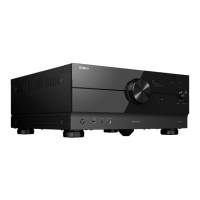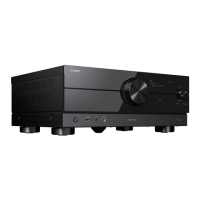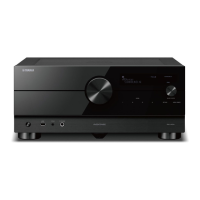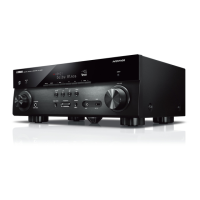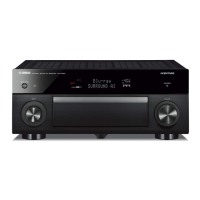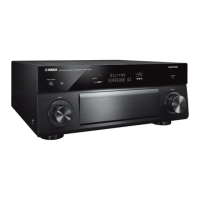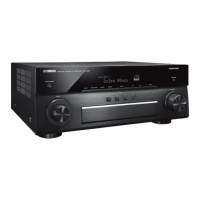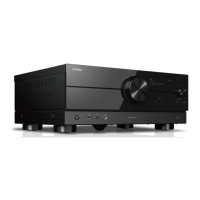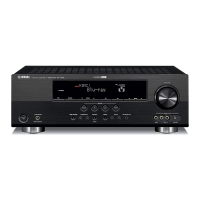
Do you have a question about the Yamaha AVENTAGE RX-A880 and is the answer not in the manual?
| Channels | 7.2 |
|---|---|
| Total Harmonic Distortion (THD) | 0.06% |
| Frequency Response | 10 Hz - 100 kHz |
| HDMI Inputs | 7 |
| HDMI Outputs | 2 |
| Audio Formats Supported | Dolby Atmos, DTS:X, Dolby TrueHD, DTS-HD Master Audio |
| HDMI eARC | Yes |
| Phono Input | Yes |
| Bluetooth | Yes |
| Zone Output | Zone 2 |
| Input Sensitivity/Impedance | 200 mV / 47 kΩ |
| Power Output (8 ohms) | 100 W |
| Network Connectivity | Wi-Fi, Ethernet |
| Rated Output Power (1kHz, 1ch driven) | 160 W (6 ohms, 10% THD) |
| Dynamic Power per Channel (8/6/4/2 ohms) | 220 W |
| Dimensions (W x H x D) | 435 x 171 x 382 mm (with antenna up: 435 x 247 x 382 mm) |
| Signal-to-Noise Ratio | 110 dB |
| Audio Inputs/Outputs | 2 digital coaxial inputs |
Provides guidelines for reading the manual and understanding warning symbols.
Lists the accessories supplied with the product for user verification.
Explains how to use the remote control, including battery insertion and operating range.
Outlines the various capabilities of the unit, including speaker systems, YPAO, and network content.
Identifies and explains the function of each control and jack on the unit's front panel.
Details the indicators and information displayed on the unit's front display.
Identifies and explains the function of each connection jack on the unit's rear panel.
Explains the function of each button on the supplied remote control.
Guides on connecting speakers, including names, systems, and requirements.
Instructions for connecting the unit to a TV via HDMI, including ARC support.
Details on connecting video and audio playback devices using HDMI or other methods.
Instructions for connecting FM/AM and DAB/FM antennas for radio reception.
Steps for preparing wired and wireless network connections for the unit.
Guidance on positioning wireless antennas for optimal network and Bluetooth connectivity.
Instructions for connecting external power amplifiers and trigger-compatible devices.
Steps for safely plugging in the power cable, including voltage selector guidance.
Guide to selecting the desired language for the on-screen setup menu.
Manual configuration of speaker settings before YPAO measurement.
Automatic speaker setup using YPAO microphone for room acoustics optimization.
Procedure for adding the unit to the MusicCast network and configuring wireless settings.
Discusses various sound programs and surround decoders for playback sources.
Recommendations for sound programs based on content type like movies or music.
How to create a surround sound field using only front speakers.
Setting up surround sound with front speakers when rear placement is not possible.
How to enjoy surround or sound field effects with stereo headphones.
How to play audio without sound field effects using straight decode or surround decoders.
Using Pure Direct mode for playback with minimal circuitry for Hi-Fi sound quality.
Enhancing bass response using the Extra Bass feature.
Improving playback of compressed music formats with Compressed Music Enhancer.
Experiencing realistic, multi-directional sound from Dolby Atmos and DTS:X content.
Utilizing the multi-zone function to play audio in different rooms simultaneously.
Step-by-step guide for playing back video and music from connected external devices.
How to select the HDMI OUT jack for video/audio output to TVs or projectors.
Guide to displaying various items on the front panel display using the INFO key.
Explains the elements displayed on the TV's playback screen when connected via HDMI.
Details the elements of the browse screen shown on the TV when selecting input sources.
How to set FM/AM tuning frequency steps according to region or country.
Tuning into radio stations by specifying their frequency.
Accessing registered radio stations by selecting their preset number.
Automatically registers strong FM radio stations as presets.
Manually registering a radio station to a preset number.
Removing specific radio stations registered to preset numbers.
Clearing all radio stations registered to preset numbers.
Viewing RDS information like program service and type for FM stations.
Instructions for performing an initial scan to receive DAB radio stations.
Selecting a DAB radio station from the list stored after an initial scan.
Tuning into a registered DAB radio station using its preset number.
Registering a selected DAB radio station to a preset number.
Removing specific DAB radio stations registered to preset numbers.
Clearing all DAB radio stations registered to preset numbers.
Receiving and displaying various types of DAB information.
Checking signal reception strength for each DAB channel label.
Tuning into FM radio stations by specifying their frequency.
Accessing registered FM radio stations by selecting their preset number.
Automatically registers strong FM radio stations as presets.
Manually registering an FM radio station to a preset number.
Removing specific FM radio stations registered to preset numbers.
Clearing all FM radio stations registered to preset numbers.
Playing back music files from a Bluetooth device (e.g., smartphone) on the unit.
Using the unit to output audio wirelessly to Bluetooth speakers or headphones.
Playing back iTunes or iPhone music content on the unit via network using AirPlay.
Playing back music files stored on a USB storage device connected to the unit.
Setting up media sharing on servers like PCs/NAS for music playback.
Playing back music files stored on media servers (PCs/NAS) on the unit.
Selecting and playing back an Internet radio station.
Adding currently playing Internet radio stations to the "Favorites" folder.
Instructions for listening to music streaming services via the MusicCast CONTROLLER app.
Using the SCENE function for one-touch selection of input sources and settings.
Changing default settings and registering functions for each SCENE key.
Registering favorite content as shortcuts for direct access.
Procedure for operating the Option menu to configure playback settings.
Table detailing available playback settings and their corresponding pages.
Adjusting high-frequency (Treble) and low-frequency (Bass) levels.
Enabling YPAO Volume to automatically adjust levels based on volume.
Setting dynamic range adjustment for bitstream audio playback.
Adjusting dialogue sound volume and perceived height for clarity.
Adjusting the perceived height of dialogue sounds for better spatial localization.
Manually adjusting the delay between video and audio output.
Enabling or disabling Compressed Music Enhancer for enriched audio.
Adjusting volume differences between input sources and subwoofer volume.
Enabling/disabling video signal processing like resolution and aspect ratio.
Choosing a video source to output with the selected audio source.
Setting shuffle and repeat playback options for music files.
Switching between stereo and monaural for FM radio reception for improved stability.
Registering radio stations manually or automatically.
Removing specific radio stations registered to preset numbers.
Clearing all radio stations registered to preset numbers.
Registering Internet radio stations to the "Favorites" folder.
Removing Internet radio stations from the "Favorites" folder.
Performing an initial scan for searching DAB radio stations.
Checking signal reception strength for each DAB channel label.
Displaying current status information such as input source and DSP program.
Basic operation and overview of the unit's Setup menu for configuring functions.
Detailed setup for all speaker-related configurations.
Settings related to audio signal information and sound adjustments.
Selecting sound programs for different listening experiences, categorized by genre.
Customizing scene assignments by selecting included items.
Settings for video signal processing, HDMI output resolution, and aspect ratio.
Settings for connecting the unit to a network.
Settings for Bluetooth functionality.
Settings for managing multiple audio zones.
Settings related to system information, language, and input sources.
Combining audio from one source with video from another for playback.
Setting which input sources to skip when using the INPUT key.
Automatically renaming input sources based on Auto Rename function.
Manually renaming input sources displayed on the front panel.
Enabling/disabling Auto Play for streaming services and various input sources.
Setting which sound programs are skipped when using the PROGRAM key.
Assigning functions to the PROGRAM key on the remote control.
Assigning functions to the color keys on the remote control.
Adjusting the brightness level of the front display.
Switching the scale of the volume display between dB and numeric values.
Selecting whether to display short messages on the TV screen during operation.
Selecting an image to be used as wallpaper on the TV screen.
Setting conditions for the TRIGGER OUT jack to function based on power or source.
Specifying output level for electronic signal transmission per input.
Manually switching output level for electronic signal transmission.
Synchronizing TRIGGER OUT jack functions with main zone or Zone2 power/source.
Setting the time duration for the auto-standby function.
Enabling the eco mode to reduce unit's power consumption.
Protecting settings from accidental changes using Memory Guard.
Navigating and operating the ADVANCED SETUP menu.
Table listing ADVANCED SETUP menu items, functions, and page numbers.
Adjusting speaker impedance settings to match connected speakers.
Setting the unit's remote control ID for multiple receiver systems.
Adjusting FM/AM tuning frequency steps based on country or region.
Matching the HDMI output video signal type to the TV's format.
Disabling monitor check to specify resolution or bypass TV detection.
Selecting the format for input/output of 4K signals for compatible TVs.
Informing BD players about supported DTS formats.
Backing up and restoring all unit settings to a USB memory device.
Restoring the unit's default settings for video or all configurations.
Updating the unit's firmware using a USB memory device or network.
Checking the currently installed firmware version of the unit.
General troubleshooting steps and checks for when the unit does not function properly.
Troubleshooting steps for when the unit fails to power on.
Issues with power not synchronizing between unit and TV, often related to HDMI Control.
Troubleshooting steps for when the unit's internal microcomputer freezes.
Resolving issues where the unit turns off unexpectedly due to speaker cable shorts or other faults.
Addressing issues with the unit entering standby mode automatically due to sleep timer or inactivity.
Troubleshooting steps when the unit's internal microcomputer freezes due to electrical issues.
Solutions for remote control issues like operating range, batteries, or sensor obstruction.
Resolving issues with input selection when input skip is enabled.
Troubleshooting for non-functional color keys on the remote control.
Common audio issues including no sound, distorted sound, or volume problems.
Diagnosing and resolving sound issues for individual speakers.
Troubleshooting steps for when the subwoofer produces no sound.
Resolving no sound issues with HDMI-connected playback devices.
Troubleshooting no sound issues when HDMI Control is active.
Resolving no sound from TV issues when HDMI Control is used.
Addressing issues where only front speakers output sound on multichannel audio.
Troubleshooting steps for unwanted noise or hum during operation.
Resolving issues related to distorted sound, possibly due to high volume or connected devices.
Common video issues including no video, interrupted video, or display problems.
Troubleshooting FM/AM radio reception issues.
Troubleshooting DAB radio reception and sound issues.
Troubleshooting issues related to USB device detection, file viewing, and playback.
Troubleshooting network connectivity and feature issues.
Troubleshooting issues with the unit not detecting media servers.
Resolving issues with viewing or playing back files from media servers.
Troubleshooting issues preventing Internet radio playback.
Resolving issues with iPhone not recognizing the unit when using AirPlay.
Troubleshooting issues with mobile applications not detecting the unit.
Resolving issues where firmware update via network fails.
Troubleshooting common Bluetooth connection and playback issues.
Troubleshooting sound issues during Bluetooth playback.
Table of error messages, their causes, and remedies.
Information and procedure for updating the unit's firmware over the network.
Enjoying 5.1.2 or 5.1 channel systems with wireless speakers using MusicCast Surround.
Lists devices that support the MusicCast Surround function.
Choosing a wireless connection method based on network environment.
Easy wireless setup using the WPS button on the router.
Setting up wireless connection using iOS device settings.
Connecting wirelessly by selecting an access point from a list.
Manually setting up a wireless connection by entering network details.
Setting up wireless connection using the router's WPS PIN code.
Explains different types of video and audio jacks for connecting devices.
Explains different types of audio jacks for digital and analog audio signals.
Describes three available layout patterns for presence speakers.
Installing presence speakers on the front wall for natural sound fields.
Installing presence speakers on the ceiling for overhead sound effects.
Utilizing Dolby Enabled speakers to enjoy overhead sound.
Technical terms related to audio decoding formats used in the manual.
Definitions of audio terms like Bi-amplification and Lip Sync.
Definitions of HDMI and video terms like Component and Composite video signals.
Definitions of network terms like SSID, Wi-Fi, and WPS.
Explanations of Yamaha's proprietary technologies like CINEMA DSP and SILENT CINEMA.
Lists Bluetooth devices compatible with the unit.
Lists USB memory devices compatible with the unit, including format requirements.
Information on AirPlay 2 compatibility and iOS version requirements.
Diagram illustrating video signal flow from device to unit to TV.
How HDMI Control enables synchronized operation of connected devices.
Enabling ARC to input TV audio to the unit via HDMI.
Confirmation of HDMI signal compatibility, including HDCP and copy protection.
List of all input jacks available on the unit, including analog, digital, and HDMI.
List of all output jacks available on the unit, including speaker and pre-out terminals.
List of other jacks like YPAO MIC, REMOTE IN/OUT, and RS-232C.
Details on HDMI features, video formats, and compatible audio formats.
Specifications for the Analog Tuner section, including tuning ranges.
Specifications for USB connectivity, including mass storage class and current supply.
Specifications for Bluetooth functionality, including sink function and wireless output.
Specifications for network connectivity, including Wi-Fi functions and PC client support.
Physical dimensions of the unit, with and without antennas.
Dimensions including protrusions like legs and antennas.
The overall weight of the unit.
Lists the default settings for various options available in the Option menu.
Lists the default settings for various configurations in the Setup menu.
Lists the default settings for the ADVANCED SETUP menu options.
